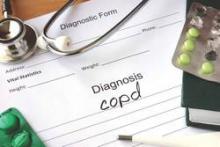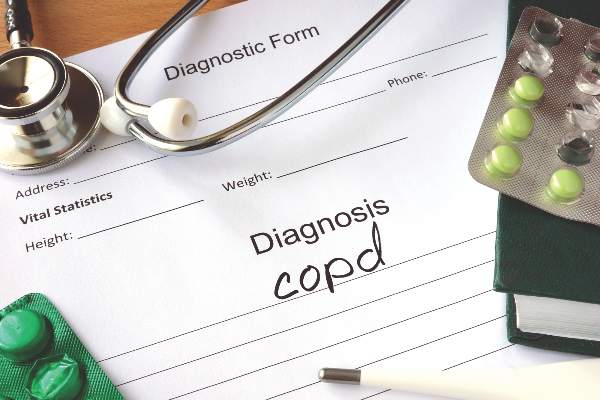User login
LONDON – Four questions from the eight-question COPD Assessment Test (CAT) provide about the same prognostic accuracy in patients with chronic obstructive pulmonary disease (COPD) as does the full CAT, according to an analysis presented at the annual congress of the European Respiratory Society.
When the four- and eight-question versions were compared for exacerbation and other clinical outcomes over a 1-year period of follow-up, “both strategies demonstrated similar discrimination,” reported Carlos H. Martinez, MD, division of pulmonary and critical care medicine, University of Michigan Health System, Ann Arbor.
The CAT is an eight-item tool for evaluating the health status of patients with COPD as well as for predicting risk of COPD-related events, particularly exacerbations. The test is designed for self-administration by patients. For each of the questions, which address symptoms and activity limitations, patients are asked to answer on a scale ranging from one (indicating no clinical burden) to five (indicating severe burden). Based on the maximum score of 40, a score below 10 signifies a low impact from COPD, a score of 10-20 signifies a medium impact, and a score above 20 signifies a high impact.
In this study, a simplified version of the CAT that employed just four of the questions was evaluated in 880 participants in the observational SPIROMICS (Subpopulations and Intermediate Outcomes in COPD Study), which was funded by the National Heart, Lung, and Blood Institute and has prospectively enrolled COPD patients at seven participating centers. Ever-smokers from SPIROMICS were eligible for this analysis if they had a forced expiratory volume in one second (FEV1)/forced vital capacity (FVC) ratio of greater than or equal to 0.70 and an FVC above the lower limit of normal.
The four questions that were retained were about cough, phlegm, chest tightness, and breathlessness. The four questions that were eliminated were about activity limitation, sleep, energy, and the effect of lung symptoms on willingness to leave the house.
With the traditional test, using a cut point of greater than or equal to 10, 51.8% were classified as having a significant COPD burden. In this group, 15.3% experienced one or more exacerbations during 1 year of follow-up. With the simplified version focused on respiratory-related symptoms alone and using a cut point of greater than or equal to 7, 45.8% were classified as having a significant COPD burden, and 15.6% had one or more exacerbations during the same period of follow-up.
“The two strategies largely identified the same individuals,” according to Dr. Martinez, who reported the agreement as 88.5% (Kappa 0.77; P less than .001). He further noted that there was no difference in the area under the curve (AUC) to predict exacerbations at 1 year.
In further analysis, “subjects identified by either method also had more depression and anxiety symptoms, poorer sleep quality, and greater fatigue [than did the lower risk group],” Dr. Martinez added.
An AUC ROC (receiver operating characteristic) statistical analysis to compare the traditional and abbreviated CATs for cross-sectional associations showed close agreement. The values were nearly identical for such variables as dyspnea, impairment as measured with the 6-minute walking distance (6MWD) test, and quality of life as measured by the St. George’s Respiratory Questionnaire (SGRQ). Similarly, the AUC ROC values diverged little or not at all for longitudinal comparisons of any exacerbation or exacerbations requiring steroids or antibiotics.
The data from this study provide “a proof of concept that simpler strategies could be used for identifying these patients [at risk of exacerbations] in primary care,” Dr. Martinez maintained. Although further validation of this four-question assessment tool is needed, Dr. Martinez implied that there is value in a relatively rapid self-assessment tool that could be interpreted quickly by clinicians.
LONDON – Four questions from the eight-question COPD Assessment Test (CAT) provide about the same prognostic accuracy in patients with chronic obstructive pulmonary disease (COPD) as does the full CAT, according to an analysis presented at the annual congress of the European Respiratory Society.
When the four- and eight-question versions were compared for exacerbation and other clinical outcomes over a 1-year period of follow-up, “both strategies demonstrated similar discrimination,” reported Carlos H. Martinez, MD, division of pulmonary and critical care medicine, University of Michigan Health System, Ann Arbor.
The CAT is an eight-item tool for evaluating the health status of patients with COPD as well as for predicting risk of COPD-related events, particularly exacerbations. The test is designed for self-administration by patients. For each of the questions, which address symptoms and activity limitations, patients are asked to answer on a scale ranging from one (indicating no clinical burden) to five (indicating severe burden). Based on the maximum score of 40, a score below 10 signifies a low impact from COPD, a score of 10-20 signifies a medium impact, and a score above 20 signifies a high impact.
In this study, a simplified version of the CAT that employed just four of the questions was evaluated in 880 participants in the observational SPIROMICS (Subpopulations and Intermediate Outcomes in COPD Study), which was funded by the National Heart, Lung, and Blood Institute and has prospectively enrolled COPD patients at seven participating centers. Ever-smokers from SPIROMICS were eligible for this analysis if they had a forced expiratory volume in one second (FEV1)/forced vital capacity (FVC) ratio of greater than or equal to 0.70 and an FVC above the lower limit of normal.
The four questions that were retained were about cough, phlegm, chest tightness, and breathlessness. The four questions that were eliminated were about activity limitation, sleep, energy, and the effect of lung symptoms on willingness to leave the house.
With the traditional test, using a cut point of greater than or equal to 10, 51.8% were classified as having a significant COPD burden. In this group, 15.3% experienced one or more exacerbations during 1 year of follow-up. With the simplified version focused on respiratory-related symptoms alone and using a cut point of greater than or equal to 7, 45.8% were classified as having a significant COPD burden, and 15.6% had one or more exacerbations during the same period of follow-up.
“The two strategies largely identified the same individuals,” according to Dr. Martinez, who reported the agreement as 88.5% (Kappa 0.77; P less than .001). He further noted that there was no difference in the area under the curve (AUC) to predict exacerbations at 1 year.
In further analysis, “subjects identified by either method also had more depression and anxiety symptoms, poorer sleep quality, and greater fatigue [than did the lower risk group],” Dr. Martinez added.
An AUC ROC (receiver operating characteristic) statistical analysis to compare the traditional and abbreviated CATs for cross-sectional associations showed close agreement. The values were nearly identical for such variables as dyspnea, impairment as measured with the 6-minute walking distance (6MWD) test, and quality of life as measured by the St. George’s Respiratory Questionnaire (SGRQ). Similarly, the AUC ROC values diverged little or not at all for longitudinal comparisons of any exacerbation or exacerbations requiring steroids or antibiotics.
The data from this study provide “a proof of concept that simpler strategies could be used for identifying these patients [at risk of exacerbations] in primary care,” Dr. Martinez maintained. Although further validation of this four-question assessment tool is needed, Dr. Martinez implied that there is value in a relatively rapid self-assessment tool that could be interpreted quickly by clinicians.
LONDON – Four questions from the eight-question COPD Assessment Test (CAT) provide about the same prognostic accuracy in patients with chronic obstructive pulmonary disease (COPD) as does the full CAT, according to an analysis presented at the annual congress of the European Respiratory Society.
When the four- and eight-question versions were compared for exacerbation and other clinical outcomes over a 1-year period of follow-up, “both strategies demonstrated similar discrimination,” reported Carlos H. Martinez, MD, division of pulmonary and critical care medicine, University of Michigan Health System, Ann Arbor.
The CAT is an eight-item tool for evaluating the health status of patients with COPD as well as for predicting risk of COPD-related events, particularly exacerbations. The test is designed for self-administration by patients. For each of the questions, which address symptoms and activity limitations, patients are asked to answer on a scale ranging from one (indicating no clinical burden) to five (indicating severe burden). Based on the maximum score of 40, a score below 10 signifies a low impact from COPD, a score of 10-20 signifies a medium impact, and a score above 20 signifies a high impact.
In this study, a simplified version of the CAT that employed just four of the questions was evaluated in 880 participants in the observational SPIROMICS (Subpopulations and Intermediate Outcomes in COPD Study), which was funded by the National Heart, Lung, and Blood Institute and has prospectively enrolled COPD patients at seven participating centers. Ever-smokers from SPIROMICS were eligible for this analysis if they had a forced expiratory volume in one second (FEV1)/forced vital capacity (FVC) ratio of greater than or equal to 0.70 and an FVC above the lower limit of normal.
The four questions that were retained were about cough, phlegm, chest tightness, and breathlessness. The four questions that were eliminated were about activity limitation, sleep, energy, and the effect of lung symptoms on willingness to leave the house.
With the traditional test, using a cut point of greater than or equal to 10, 51.8% were classified as having a significant COPD burden. In this group, 15.3% experienced one or more exacerbations during 1 year of follow-up. With the simplified version focused on respiratory-related symptoms alone and using a cut point of greater than or equal to 7, 45.8% were classified as having a significant COPD burden, and 15.6% had one or more exacerbations during the same period of follow-up.
“The two strategies largely identified the same individuals,” according to Dr. Martinez, who reported the agreement as 88.5% (Kappa 0.77; P less than .001). He further noted that there was no difference in the area under the curve (AUC) to predict exacerbations at 1 year.
In further analysis, “subjects identified by either method also had more depression and anxiety symptoms, poorer sleep quality, and greater fatigue [than did the lower risk group],” Dr. Martinez added.
An AUC ROC (receiver operating characteristic) statistical analysis to compare the traditional and abbreviated CATs for cross-sectional associations showed close agreement. The values were nearly identical for such variables as dyspnea, impairment as measured with the 6-minute walking distance (6MWD) test, and quality of life as measured by the St. George’s Respiratory Questionnaire (SGRQ). Similarly, the AUC ROC values diverged little or not at all for longitudinal comparisons of any exacerbation or exacerbations requiring steroids or antibiotics.
The data from this study provide “a proof of concept that simpler strategies could be used for identifying these patients [at risk of exacerbations] in primary care,” Dr. Martinez maintained. Although further validation of this four-question assessment tool is needed, Dr. Martinez implied that there is value in a relatively rapid self-assessment tool that could be interpreted quickly by clinicians.
AT THE ERS CONGRESS 2016
Key clinical point: A shortened risk-assessment tool with four questions appears to be as accurate for COPD risk assessment as the eight-question version.
Major finding: For predicting future COPD exacerbations, agreement between the simplified and complete assessments was 88.5%
Data source: Retrospective analysis of prospective cohort.
Disclosures: Dr. Martinez has financial relationships with Genentech, GlaxoSmithKline, and Merck.

